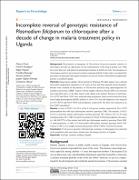| dc.contributor.author | Ocan, Moses | |
| dc.contributor.author | Katabazi, Fred A | |
| dc.contributor.author | Kigozi, Edgar. | |
| dc.contributor.author | Bwanga, Freddie. | |
| dc.contributor.author | Kyobe, Samuel. | |
| dc.contributor.author | Ogwal-Okeng, Jasper | |
| dc.contributor.author | Obua, Celestino. | |
| dc.date.accessioned | 2019-10-30T16:21:02Z | |
| dc.date.available | 2019-10-30T16:21:02Z | |
| dc.date.issued | 2016 | |
| dc.identifier.citation | Ocan, M., Katabazi, F. A., Kigozi, E., Bwanga, F., Kyobe, S., Ogwal-Okeng, J., & Obua, C. (2016). Incomplete reversal of genotypic resistance of Plasmodium falciparum to chloroquine after a decade of change in malaria treatment policy in Uganda. Reports in Parasitology, 5, 15. | en_US |
| dc.identifier.uri | https://hdl.handle.net/123456789/74 | |
| dc.description.abstract | Background: The potential re-emergence of Plasmodium falciparum parasites sensitive to chloroquine provides an opportunity for the reintroduction of the drug in patient care. With the recent discovery and spread of artemisinin resistance in South east Asia, the emergence of chloroquine sensitivity gives hope for malaria treatment globally. In this study, we explored the prevalence of genotypic chloroquine resistant P. falciparum isolates collected from symptomatic patients in northern Uganda.
Methods: Finger-prick capillary blood spotted on Whatman 903 filter papers were collected from adult symptomatic outpatients ($18 years) in Lira and Gulu regional referral hospitals. Patients were screened for the presence of Plasmodium infection using rapid diagnostic test histidine rich protein-2 (HRP- 2) prior to blood sample collection. Parasite DNA was extracted from individual spots on the filter papers using chelex-resin method. Presence of mutations, Pfcrt K76T and Pfmdr N86Y were analyzed using polymerase chain reaction-restriction fragment length polymorphism (RFLP) method. A total of 213 and 169 amplicons were analyzed for Pfcrt K76T and Pfmdr N86Y polymorphisms, respectively. The data were analyzed in an Excel 2007 spreadsheet.
Results: A total of 89/213 (41.8%) of the P. falciparum isolates analyzed for Pfcrt K76T polymorphism had wild type (chloroquine sensitive) genotype (76K). The majority, 116/213 (54.4%) carried the mutant (chloroquine resistant) genotype 76T whereas 8/213 (3.8%) had mixed genotypes Pfcrt-76K/T (sensitive/resistant). For Pfmdr N86Y polymorphisms, the majority, 164/169 (97%) of the isolates had wild type (chloroquine sensitive) genotype Pfmdr 86N. A small proportion, (3/169) 1.8% had mutant (chloroquine resistant) genotype Pfmdr 86Y, whereas 2/169 (1.2%) samples had mixed genotypes Pfmdr1-86N/Y (sensitive/resistant).
Conclusion: P. falciparum parasites with genotypic resistance to chloroquine have persisted in the population after more than a decade since the change of policy in Uganda. | en_US |
| dc.language.iso | en | en_US |
| dc.publisher | Reports in Parasitology | en_US |
| dc.subject | Northern Uganda | en_US |
| dc.subject | Uganda | en_US |
| dc.subject | Genotypic resistance | en_US |
| dc.subject | Plasmodium falciparum | en_US |
| dc.subject | Malaria | en_US |
| dc.subject | Chloroquine | en_US |
| dc.title | Incomplete reversal of genotypic resistance of Plasmodium falciparum to chloroquine after a decade of change in malaria treatment policy in Uganda | en_US |
| dc.type | Article | en_US |

